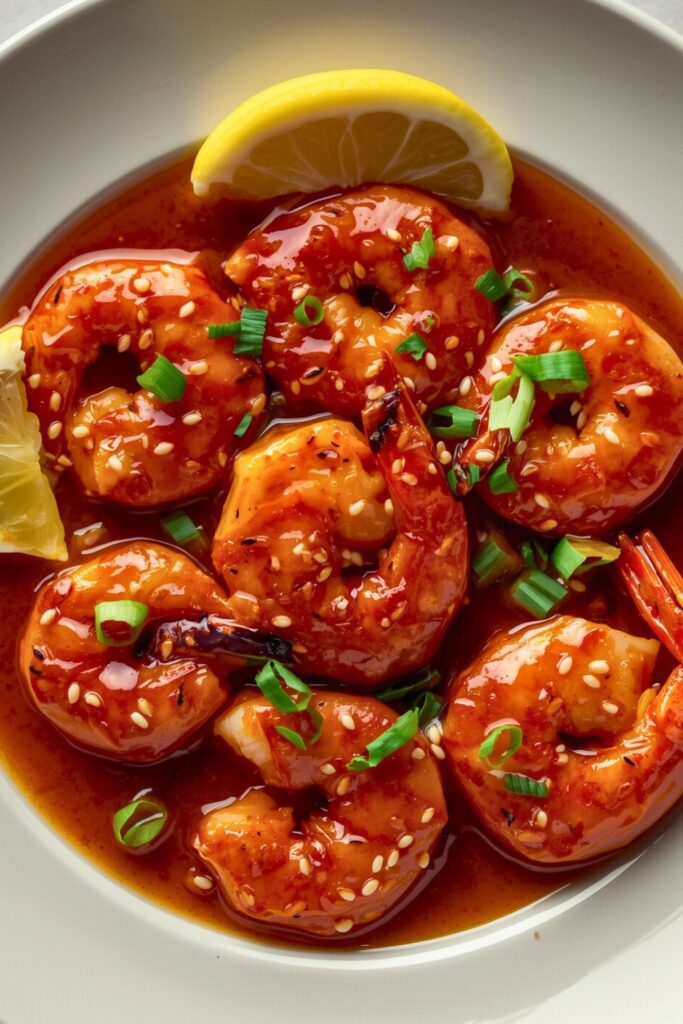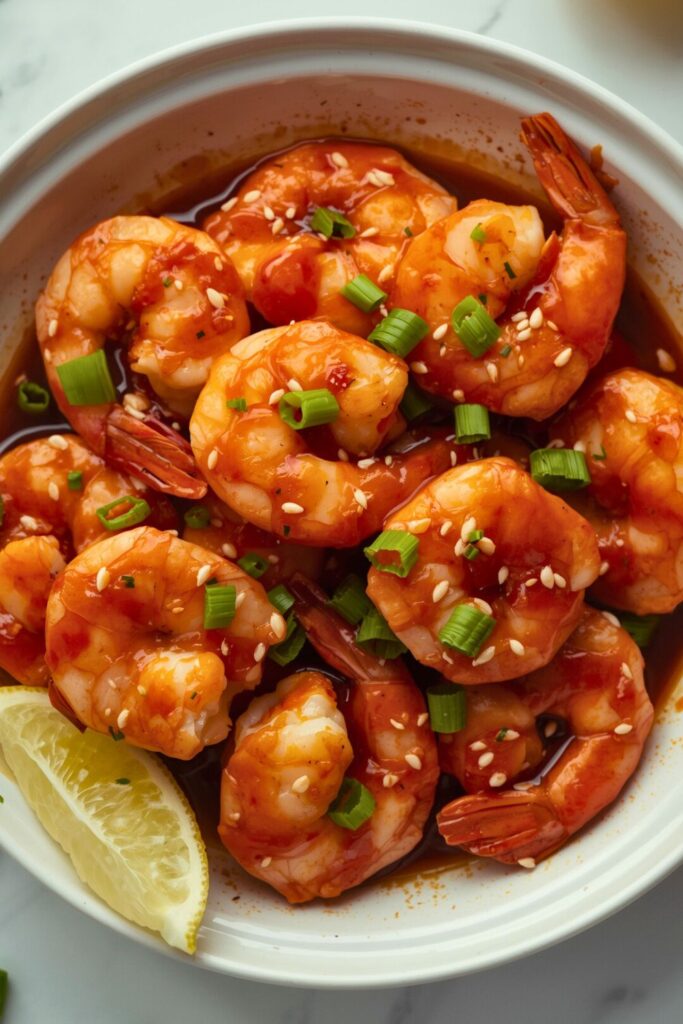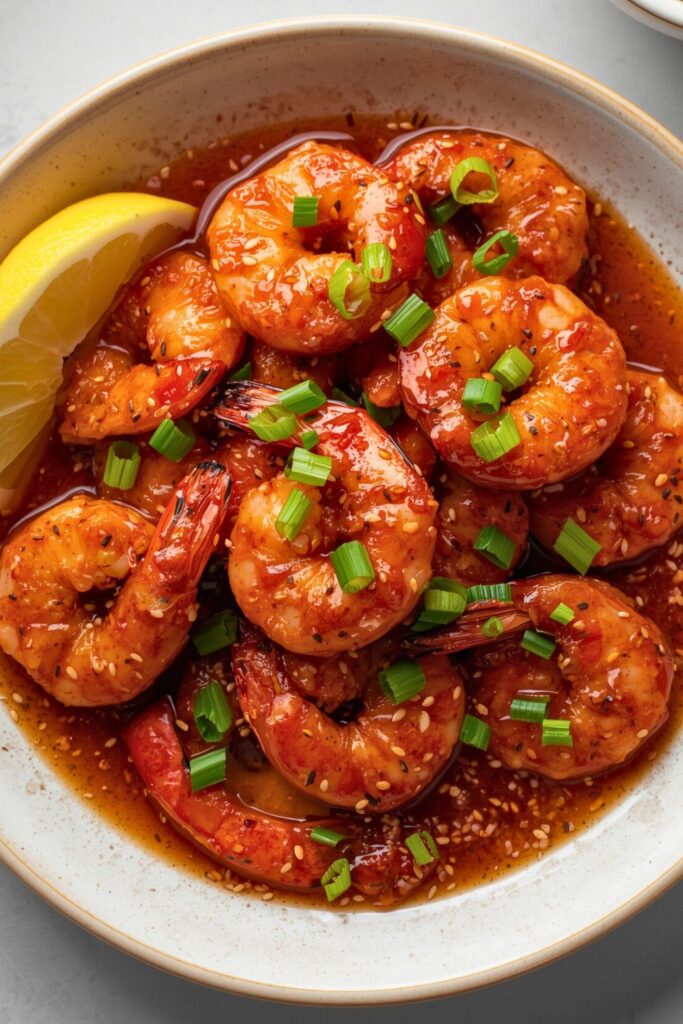Picture this: I’m standing in my tiny Seoul kitchen at midnight, jet lagged and desperately craving something that’ll wake up my taste buds. My Korean neighbor had just handed me a container of homemade gochujang with a knowing smile. “Try this with shrimp,” she whispered. “It’ll change your life.”
She wasn’t kidding.
That first bite of sweet and spicy gochujang shrimp didn’t just satisfy my hunger, it rewrote everything I thought I knew about balancing heat and sweetness. The umami rich fermented chili paste coated each plump shrimp like liquid silk, while brown sugar and rice vinegar danced together in perfect harmony. One taste and I was completely hooked.
This sweet and spicy gochujang shrimp recipe delivers something extraordinary: a perfect marriage of Korean fermented complexity and seafood simplicity. Here’s what makes this dish absolutely magical: gochujang isn’t your typical hot sauce. This Korean fermented masterpiece brings complexity that’ll make your regular sriracha weep with envy. We’re talking deep, earthy heat that builds slowly, sweetness that doesn’t overwhelm, and an umami depth that keeps you coming back for more. Combined with perfectly cooked shrimp, it creates something that’s become my go to dish when I wanna impress without stressing.
The best part? This isn’t some complicated restaurant technique that’ll have you crying into your mise en place. It’s a straightforward recipe that delivers restaurant quality results in about 20 minutes. Perfect for those weeknight moments when takeout feels lazy but you’re too tired for anything fancy.
Why Sweet and Spicy Gochujang Shrimp Deserves Your Attention

Let me tell you why this sweet and spicy gochujang shrimp has earned permanent residence in my weekly rotation. First, gochujang brings incredible fermented complexity you can’t replicate with regular chili flakes or hot sauce. It’s been aging and developing flavors for months, sometimes years, creating this perfect balance of sweet, spicy, salty, and umami that hits every single taste receptor.
The technique here is pure genius too. Instead of drowning the shrimp in sauce, we create what I call a “flavor glaze” concentrated, glossy, and just enough to coat each piece without masking the natural sweetness of the seafood.
Plus, this sweet and spicy gochujang shrimp scales beautifully. Making dinner for two? Perfect. Hosting a dinner party? Double or triple it without breaking a sweat. The flavors actually get better when you’re cooking larger quantities because you get more caramelization happening in the pan.
This dish transforms ordinary weeknight cooking into something special. The gochujang brings that restaurant quality depth, while the technique stays simple enough for busy schedules.
Essential Ingredients for Sweet and Spicy Gochujang Shrimp
Here’s everything you need for perfect sweet and spicy gochujang shrimp, listed exactly in the order you’ll use them:
For the Shrimp:
- 1½ pounds large shrimp (21-25 count), peeled and deveined
- 2 tablespoons neutral oil (vegetable or avocado work great)
- 3 cloves garlic, minced fine
- 1 tablespoon fresh ginger, grated
For the Gochujang Glaze:
- 3 tablespoons gochujang paste
- 2 tablespoons brown sugar (light or dark, your choice)
- 2 tablespoons rice vinegar
- 1 tablespoon soy sauce (low sodium preferred)
- 1 tablespoon sesame oil
- 1 teaspoon cornstarch mixed with 1 tablespoon water
For Finishing:
- 2 green onions, sliced thin on the bias
- 1 tablespoon toasted sesame seeds
- Fresh cilantro leaves (optional but recommended)
Smart Ingredient Swaps That Actually Work
Can’t find gochujang at your local store? Don’t panic. Mix 2 tablespoons tomato paste with 1 tablespoon sriracha, 1 teaspoon brown sugar, and ½ teaspoon garlic powder. It won’t have that fermented depth, but it’ll still deliver serious flavor for your sweet and spicy gochujang shrimp.
Brown sugar running low? Honey works beautifully here, just use about 1½ tablespoons instead. Maple syrup adds subtle complexity too.
Rice vinegar brings mild acidity, but apple cider vinegar works in a pinch. Just use less since it’s sharper.
Here’s something most people don’t know: shrimp type makes huge difference. I choose wild caught when possible, they’ve got better flavor and firmer texture. Frozen works fine, just thaw them properly in the fridge overnight. Never use the microwave or hot water method, you’ll end up with mushy results.
Size matters too. Those tiny salad shrimp overcook before you blink. Go for large or extra large, they handle heat and give you that satisfying bite we’re after in this sweet and spicy gochujang shrimp.
Step by Step Sweet and Spicy Gochujang Shrimp Magic

Getting Your Shrimp Ready
Start by patting those shrimp completely dry with paper towels. This isn’t optional, any moisture causes splattering and prevents that beautiful sear we’re chasing. I lay them out on a clean kitchen towel for about 10 minutes while I prep everything else.
Season them lightly with salt and pepper. Don’t go heavy handed here since the gochujang glaze brings plenty of sodium.
Building the Perfect Gochujang Glaze
In a small bowl, whisk together your gochujang, brown sugar, rice vinegar, soy sauce, and sesame oil until smooth. This paste can be pretty thick, so really work it until everything combines. Set your cornstarch slurry nearby, we’ll need it later.
Pro tip: taste this mixture now. It should hit sweet, salty, and spicy notes in equal measure. Too sweet? Add more vinegar. Not enough heat? Another teaspoon of gochujang won’t hurt your sweet and spicy gochujang shrimp.
The Cooking Process That Creates Magic
Heat your oil in a large skillet or wok over medium high heat. You want it hot enough that a water drop sizzles immediately, but not smoking.
Add the shrimp in a single layer, don’t overcrowd them. If your pan’s too small, work in batches. We’re looking for about 2 minutes on the first side without moving them around. This creates that gorgeous golden crust that adds texture and flavor.
Flip them over and cook another minute until they’re just opaque in the center. Remove the shrimp to a plate immediately, they’ll finish cooking in the sauce.
In the same pan, add your minced garlic and ginger. Stir constantly for about 30 seconds until fragrant. Don’t let them burn or you’ll get bitter flavors in your sweet and spicy gochujang shrimp.
Pour in your gochujang mixture and let it bubble for about a minute. Add the cornstarch slurry and whisk until the sauce thickens noticeably, about another 30 seconds.
Return the shrimp to the pan and toss everything together until every piece is glossy and coated. This should take less than a minute since the shrimp are already cooked.
Common Pitfalls and How to Avoid Them
The biggest mistake I see people make? Overcooking the shrimp. These little guys go from perfect to rubbery in seconds. If they start curling into tight C shapes, you’ve gone too far.
Don’t skip the cornstarch slurry. Without it, your sauce stays thin and won’t cling properly to the shrimp. You want that glossy, restaurant style coating that makes sweet and spicy gochujang shrimp so irresistible.
Watch your heat levels too. If the sauce starts caramelizing too quickly and turning dark, lower the heat immediately. We want concentration, not burnt flavors.
The Science Behind Sweet and Spicy Gochujang Shrimp
What makes gochujang so special comes down to fermentation. Just like good wine or aged cheese, this paste develops complex flavors through months of controlled fermentation. The beneficial bacteria break down proteins and starches, creating amino acids that give us that incredible umami punch in our sweet and spicy gochujang shrimp.
Brown sugar isn’t just for sweetness, it creates a Maillard reaction with the proteins in the shrimp and the amino acids in the gochujang. This reaction produces hundreds of new flavor compounds that give us those deep, caramelized notes.
Rice vinegar brings acidity that brightens everything while helping to balance the richness of the sesame oil. It also helps the cornstarch activate properly, giving us that perfect glossy finish on our sweet and spicy gochujang shrimp.
The brief high heat searing creates what chefs call the “fond” those golden bits that stick to the pan. When we deglaze with our sauce, we capture all that concentrated flavor and incorporate it into our glaze.
Why This Technique Works Better
Traditional stir frying often calls for cooking everything together at once, but our two step method prevents overcooking while maximizing flavor development. By searing the shrimp first, we get textural contrast that makes this sweet and spicy gochujang shrimp special. By building the sauce separately, we control the consistency perfectly.
The sesame oil goes in with the sauce rather than for cooking because it has a low smoke point. Adding it at the end preserves its nutty aroma and prevents any bitter notes from developing.
Equipment That Makes the Difference
The right pan changes everything for sweet and spicy gochujang shrimp. A large stainless steel skillet or carbon steel wok works best, they retain heat well and create better caramelization. Non stick pans work in a pinch, but you won’t get the same fond development.
A good whisk makes sauce preparation effortless. Gochujang can be stubborn to combine, so don’t try mixing it with a fork.
Making Sweet and Spicy Gochujang Shrimp Beautiful and Restaurant Worthy
Presentation doesn’t need complexity to look professional. I serve this sweet and spicy gochujang shrimp over jasmine rice that’s been fluffed with a fork, the grains should be separate and light, not sticky.
Arrange the shrimp in an overlapping pattern rather than dumping them on the plate. Drizzle any extra sauce around the edges of the plate, not just on top of the food.
Those sliced green onions aren’t just garnish, scatter them generously over everything. The sharp bite cuts through the richness perfectly. Same with the sesame seeds, toast them in a dry pan for about 2 minutes until golden and fragrant. The difference in flavor is remarkable.
Fresh cilantro adds a bright, herbaceous note that complements the fermented flavors beautifully. If you’re in the “cilantro tastes like soap” camp, try fresh Thai basil instead.
Perfect Pairings for Sweet and Spicy Gochujang Shrimp
This dish begs for something to balance all that rich, spicy goodness. Steamed broccoli with just a touch of sesame oil works perfectly. The slight bitterness plays beautifully against the sweet and spicy gochujang shrimp.
For wine lovers, a crisp Riesling or Gewürztraminer handles the heat while complementing the sweetness. Beer drinkers should reach for something with citrus notes, a wheat beer or pilsner cuts through the richness perfectly.
Rice is traditional, but don’t overlook rice noodles or even cauliflower rice for a lighter option. The key is having something neutral that lets the gochujang flavors shine in your sweet and spicy gochujang shrimp.
Storage and Meal Prep Tips
Sweet and spicy gochujang shrimp keeps well in the refrigerator for up to three days. Store the shrimp and any leftover sauce separately to maintain the best texture.
For meal prep, cook the shrimp and sauce separately. Store them in airtight containers and combine when reheating. This prevents the shrimp from becoming tough.
Reheat gently in a skillet over low heat, adding a splash of water if the sauce has thickened too much. Don’t microwave, it makes the shrimp rubbery.
Sweet and Spicy Gochujang Shrimp Variations to Try

Once you’ve mastered the basic sweet and spicy gochujang shrimp, the flavor possibilities expand dramatically. Try adding fresh pineapple chunks during the last minute of cooking for tropical sweetness that pairs beautifully with the fermented heat.
Scallops work magnificently with this same technique. Just reduce the cooking time to about 1-2 minutes per side since they’re more delicate than shrimp.
For vegetarian options, try this glaze with thick slices of eggplant or firm tofu. The key is getting good caramelization on your protein before adding the sauce.
Add snap peas or bell peppers for extra crunch and color. Toss them in during the last 30 seconds to keep them crisp tender.
Final Thoughts
This sweet and spicy gochujang shrimp represents everything I love about cooking, bold flavors, simple techniques, and results that look way more complicated than they actually are. It’s become my secret weapon for impressive weeknight dinners and casual entertaining alike.
The beauty lies in the balance. That fermented heat from the gochujang, the caramelized sweetness, the bright acidity, every element supports the others without competing. And those perfectly cooked shrimp? They’re the ideal canvas for this flavor masterpiece.
Master this technique and you’ll find yourself applying it to chicken, pork, even vegetables. The method stays the same, just adjust cooking times accordingly.
Remember, great cooking isn’t about following rules perfectly it’s about understanding flavors and techniques well enough to make them your own. Once you’ve nailed this basic sweet and spicy gochujang shrimp, start playing. Add some grated fresh pineapple for tropical notes. Try it with scallops instead of shrimp. Mix in some snap peas for crunch.
Most importantly, don’t fear that gochujang. Yes, it’s got heat, but it’s a sophisticated, buildable heat that adds complexity rather than just burning your tongue. Trust the process, taste as you go, and adjust to your preferences.
This sweet and spicy gochujang shrimp will become one of those recipes you return to again and again, each time discovering something new about the interplay of sweet, spicy, and umami flavors.
Frequently Asked Questions
Can I make sweet and spicy gochujang shrimp ahead of time?
This dish really shines when served immediately, but you can prep all your ingredients hours ahead. Keep the cooked shrimp and sauce separate until you’re ready to serve, just reheat the sauce gently and toss everything together. The texture stays better this way than reheating the complete sweet and spicy gochujang shrimp dish.
What if my gochujang glaze is too thick or thin?
Too thick? Add a tablespoon of water or chicken stock and whisk it in. Too thin? Mix another teaspoon of cornstarch with a tablespoon of cold water and stir it in while the sauce simmers. The sauce should coat the back of a spoon but still flow easily.
How spicy is sweet and spicy gochujang shrimp really?
Gochujang brings moderate heat, think somewhere between sriracha and jalapeño peppers. The brown sugar and rice vinegar mellow it considerably. If you’re heat sensitive, start with 2 tablespoons of gochujang and add more next time if needed. For heat lovers, bump it up to 4 tablespoons and add a pinch of red pepper flakes.
Can I use frozen shrimp for this recipe?
Absolutely! Just thaw them completely in the refrigerator overnight and pat them extra dry before cooking. Frozen shrimp sometimes retain more water, so take extra care with the drying step. The flavor and texture will be virtually identical to fresh in your sweet and spicy gochujang shrimp.
What’s the best way to store leftover gochujang?
Keep it in the refrigerator in its original container or transfer to an airtight jar. It’ll stay good for up to a year, the fermentation actually helps preserve it. If you notice any mold or off smells, toss it, but properly stored gochujang rarely spoils. This makes it perfect for multiple batches of sweet and spicy gochujang shrimp.

Swiftly Captions by Tina Smith — Quick, flavorful food recipes made simple, bringing fresh inspiration to your kitchen every day






